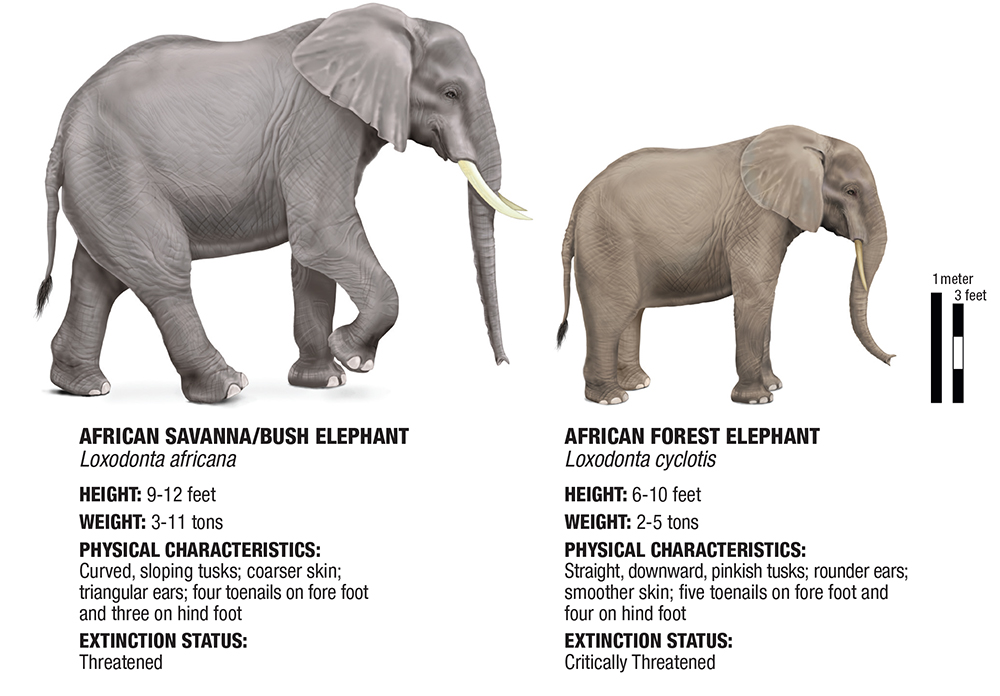Distant Relatives
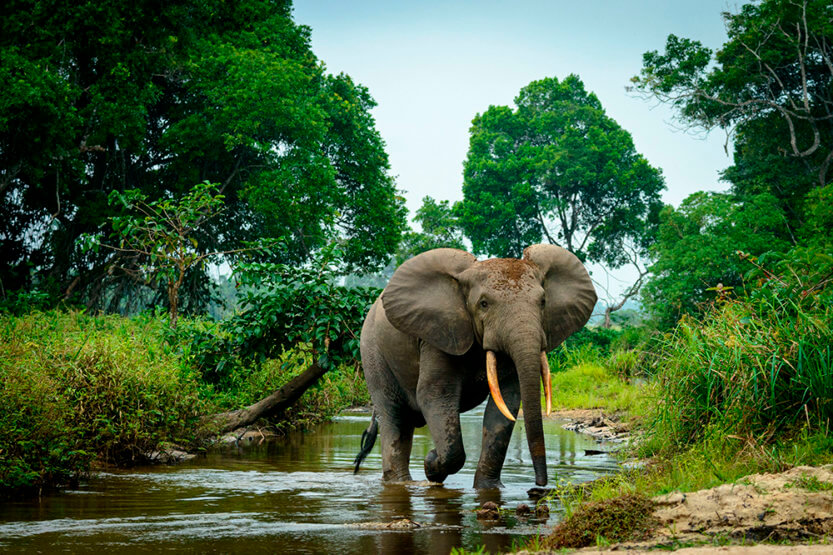 An African forest elephant traverses the Lekoli River in the Odzala-Kokoua National Park, Cuvette-Quest Region, Republic of the Congo. African forest elephants inhabit the rainforests of eastern and southern Africa.(Image by Education Images/Universal Images Group via Getty Images)
An African forest elephant traverses the Lekoli River in the Odzala-Kokoua National Park, Cuvette-Quest Region, Republic of the Congo. African forest elephants inhabit the rainforests of eastern and southern Africa.(Image by Education Images/Universal Images Group via Getty Images) In science, as in all of life, there are matters a posteriori—meaning they have to be proved—and matters a priori—which is to say, self-evident. That U of I Professor Alfred (Al) Roca is partial to elephants is a priori. A molecular biologist, Roca is well-versed in white-tailed deer, koalas, giant silk moths and white rhinos, to name just a few of the creatures he’s studied. But elephants keep pushing to the forefront of his work.
In 2001, a storm of international publicity ensued when Roca and colleagues made a decisive case for a new species of elephant. Based on two decades of genomic research, Loxodonta cyclotis, the African forest elephant, became a species in its own right. Formerly, it had been classified as a sub-species of Loxodonta africana, a designation built around the more familiar savannah elephant. But savannah elephants and forest elephants are surprisingly different.
“We found differences between the two species that were substantially greater than, for example, the difference between polar bears and brown bears,” Roca explains. Coverage ran in The New York Times, National Geographic and a whole slew of other publications worldwide and on major television networks in the U.S.
The forest elephant is not only removed geographically from the savannah elephant—the former shelters in the rainforests of eastern and southern Africa, while the latter gregariously occupies most of the rest of the continent—the two species are far separated in time. And, not that close romantically, either. On the rare occasions of interbreeding, the two don’t produce offspring that have genes robust enough to begin a new lineage—perhaps because Loxodonta africana and Loxodonta cyclotis diverged between 4 million and 5 million years ago.
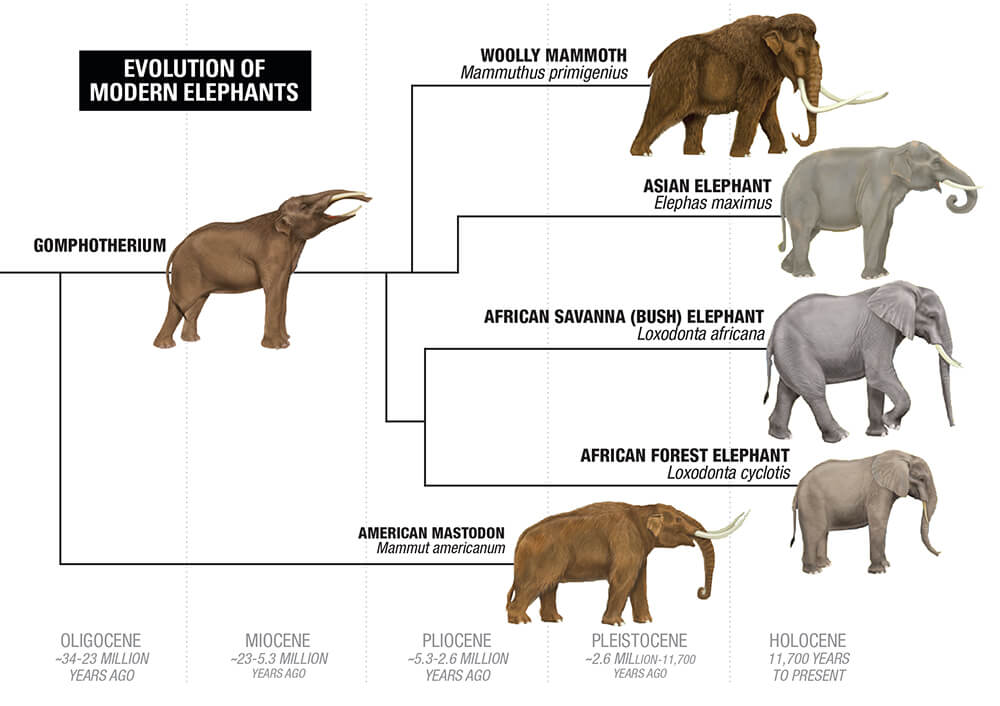
The African forest elephant and African bush elephant diverged 4 million to 5 million years ago. The genomic differences between the two are “substantially greater than, for example, the difference between polar bears and brown bears,” says Alfred Roca, U of I professor of molecular biology and animal sciences, whose DNA analysis helped prove that the animals were two distinct species. (Images reprinted with permission from Encyclopaedia Britannica, ©2014 by Encyclopædia Britannica, Inc.)
Alas, longevity counts for little in evolution and even less in today’s world. A century ago, 10 million elephants wandered Africa. That number has shrunk to a current total of 400,000, just 50,000 of which are estimated to be forest elephants. (Exact numbers are, like the species itself, elusive.) “There was one study that found a three-fifths reduction in the forest elephant population in the space of about a decade,” Roca says. “And my guess is that it’s gone down even more since then.” Thus, Roca helped identify a species only to find it facing extinction from an inexorable loss of habitat and the abomination of poaching.
Forest elephants are small, for elephants anyway—eight feet at the shoulder, which is two to four feet less than their mighty counterparts in the African bush. Their penchant for mud baths imbues their gray skin with a crusty brown layer that blocks the sun. Their ears are comparatively smaller and rounder, their tusks comparatively shorter and downward pointing. Their ivory is tinged pink and, alas, highly sought after by poachers. Their smaller stature and darker color befit their habitat in the Guinean rainforests and the Congo basin, a vast swath across Gabon, Cameroon, Democratic Republic of the Congo, Ghana and the Ivory Coast.
The forests that remain are Edens of fruit- and nut-bearing trees and shrubs and edible plants and grasses, all-you-can-eat buffets along which elephants yearly trek in a 700-square-mile migration. Their ongoing feast, supplemented by visits to mineral licks and watering holes, is as good for the ecology as it is for the animals. As the latter shamble on, they spread seeds and fertilize the soil with their dung, planting flowers, shrubs and trees everywhere, contributing to the area’s tremendous biological diversity, and winning themselves the nickname “mega-gardener of the forest.”
The benefit of this throughput to African flora and the world is offset by the loss of habitat. Dense, beautiful rainforests teeming with life forms at every level of scientific classification are being cut down for cattle ranches, industrial farms and burgeoning occupation by humans, many of whom fear and hate the animals. Elephants don’t appreciate the roads, canals and fences that interrupt their lives. They raid crops and sometimes attack people. Saving them is a steep climb and a fraught journey.
Hansken—the pick-pocketing elephant
Roca went into genetics knowing that he wanted to help conserve wildlife. He holds a doctorate in neuroscience from Harvard and was a post-doc in the Laboratory of Genomic Diversity at the National Cancer Institute. But when he ultimately got tenure at Illinois, the book he chose to be shelved in the Library in his honor (a faculty tradition at the U of I) was Wildlife in Danger by James Fisher, which he read when he was a boy. “It was in my local library and I was fascinated by it,” Roca recalls. “That book, as much as anything, played a role in my interest in wildlife conservation.”
Through two decades of research, Roca has taken on a myriad of wildlife questions and challenges, ranging from feline leukemia and zombie deer to koala retroviruses, woolly mammoth DNA and tracking polar bears with microsatellites. (He also teaches courses on zoo animal conservation and population genetics, and runs a lab at Illinois, where he is a professor of animal sciences.)
Some projects have proven not a little strange. Like the fetal elephant preserved in alcohol three centuries ago that found its way from a “cabinet of curiosities” collected by a Dutch pharmacist to the Swedish Museum of Natural History. This tiny creature was designated a species type of Elephas maximus—the Asian elephant—by Carl Linnaeus, father of taxonomy. Roca was part of a project using DNA and protein analysis to show that the fetus was, in fact, an African elephant.
The action then moved to Italy and a 350-year-old assembly of elephant bones, propped up by wooden replicas of the specimen’s missing ribs and sternum, on display in La Specola, a natural history museum located in Florence. DNA collected from the specimen, shored by historical records, revealed her to almost certainly be Hansken. Hansken was a performing elephant who was imported from Sri Lanka and got trundled around Europe, picking the pockets of onlookers, firing a pistol (what could go wrong?) and getting sketched in chalk by Rembrandt (four times). She died in Florence in 1655. But immortality awaited Hansken. Following the analysis, to which Roca contributed, she was deemed the specimen type of Elephas maximus, a title passed along from the fetal elephant back in Sweden.
Naturalists have traditionally categorized species by using animals preserved in museums and by distinguishing physical attributes—the “Loxodonta” in the African elephants’ names, for example, refers to their lozenge-shaped molars. But genomics has turbo-charged taxonomy into a brave new world of infinite detail and sub-microscopic precision. DNA analysis has become so familiar that it’s easy to overlook its complexity.
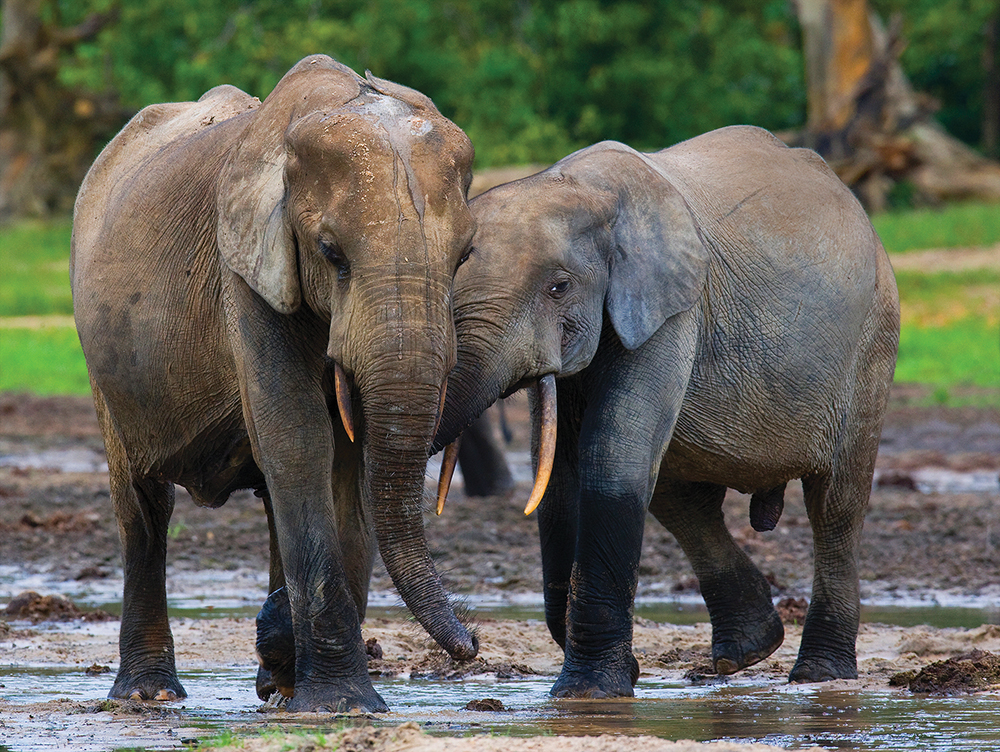
African forest elephants gather at the watering hole in a Dzanga-Sangha Special Reserve, Republic of the Congo. (Image by Gud Kovandrey/123RF)
There are approximately 3.2 billion base pairs in the elephant genome (in the same range as humans). That is, to repeat, 3.2 billion nucleotides of DNA, half from each parent, doubled up and coiled into the nucleus of every cell in the body (except red blood cells). Every cell contains complete instructions that determine every physical and neurological feature of the body—from toenail shape to brain size to aptitude for picking pockets of bystanders at traveling shows.
The cells also hold DNA in their mitochondria, tiny power plants that take in glucose and produce energy. Unlike the DNA in the cell nucleus, mtDNA has a relatively small genome (16,000 base pairs in elephants) of instructions to the cell on how to produce energy. Also, unlike nuclear DNA, it comes from the mother only.
MtDNA offers an information-rich shortcut to tracing ancestry, through genes that provide a record of shared maternal ancestors and thus of matriarchal lineages. MtDNA also can reveal the locations and movements of those lineages along paths of descent that, in the case of elephants, are millions of years old.
Much has been made of the “mitochondrial Eve.” A composite woman whom all humans share as an ancestor, this Ur-female lived 150,000 years ago at the beginning of a lineage carried on by her daughters, mutations diverging at more recent common ancestors and at those more recent still. There also is a case for an Eve elephant, Primelephas, a four-tusked elephantid whose lineage may have branched into African and Asian elephants and mammoths between 4 million and 6 million years ago. (Fossil evidence for such a creature is inconclusive.)
Further along the family tree, the African forest elephant is less related to the African savannah elephant than it is to Paleoloxodon antiquus, the straight-tusked elephant. This enormous beast, long extinct, roamed western Asia and Europe through the last Ice Age, 400,000 years ago.
Seized ivory’s DNA
The family bonds of elephants are strong and well defined. They live in female-led herds, connoted as “fission-fusion” societies in which membership shifts according to group needs. Male elephants are forced out by females once they have reached maturity. The mothers—who also are sisters and aunts and grandmothers to one another within the herd—tend to the young and teach them how to find food on the long treks that revolve through the seasons and the decades. An idyllic arrangement, outside the occasional loss of a calf to a lion or other predator, and one that has proved itself across the eons. That is, until a few hundred years ago when ships started putting in off the coast, and men carrying guns disembarked. Now criminals armed with the most powerful weapons the black market has to offer slaughter whole herds, including the tuskless calves because they can be sold for meat.
People who, like Roca, are partial to elephants fear that poaching won’t stop until there are no elephants left to be killed. While a moratorium on ivory led by the U.S. went into effect in 2016 and was affirmed by China in 2018, millions of dollars’ worth of contraband tusks still flow into the markets of Japan, Laos, Vietnam, Thailand and Hong Kong, where they are carved and sold to people who must either not know or not care about the cruelty behind what they’re buying.
The forest elephant is particularly endangered, and in its defense, Roca and his team at Illinois have opened access to their database, Loxodonta Localizer. This online tool can match DNA from ivory seized by customs inspectors to known sequences from elephants throughout Africa. Officials impounding ivory in Hong Kong and Malaysia have had the tusks analyzed and been able to alert African conservation authorities to the presence of poachers in specific countries and geographic areas.

Roca and his research team—(left to right) Cory Green, Tolulope Perrin-Stowe and Alida de Flamingh; not pictured are Kai Zhao, Yasuko Ishida and Cassie Donnelly—contributed DNA sequences for 500 elephants across 23 locations in African to the Loxodonta Localizer, a library of genomic information, which is used by customs inspectors to track poached ivory. (Image by Fred Zwicky/UI public Affairs)
The library of genomic information available through Loxodonta Localizer comes from decades of work by elephant researchers. Roca and his team alone have contributed sequences from 500 elephants across 23 locations in Africa. Among the samples on which the sequences are based is a set procured for Roca in the 1990s by Nicholas Georgiades. A fearless British researcher, who at one point was charged by an elephant that overturned his vehicle, Georgiades used a special dart gun to nick off minute quantities of the elephants’ skin, obviating the need for anesthesia or other invasive collection methods. Partialities notwithstanding, Roca himself doesn’t get up close and personal with elephants much, beyond well-guided Study Abroad safaris with his U of I students, research assignments at zoos and museum encounters with characters like Hansken. “I know of people who have been killed by elephants,” Roca says. “They are dangerous animals.”
Loxodonta Localizer is one effort in a worldwide campaign to save elephants, which also are threatened in India and Indonesia. Perhaps these efforts will prevail. Elephants are powerful not only in what they are—creatures that rule the forest without killing fellow creatures—but in what they symbolize and what their stories tell about themselves and the world.
The Hindu pantheon includes the elephant deity Ganesha, a whimsical, fun kind of god (plus patron of writers). Babar, Horton and Dumbo are beloved by generations of children. Elephants are in rooms where no one will talk about them and in dreams where they are pink and on parade and atop the promotional materials of political parties. Mark Twain has written of elephants. So has Rudyard Kipling, whose story “The Elephant’s Child” tells of the first elephant to have a trunk, a baby that got grabbed on the nose by a crocodile and stubbornly pulled back until that nose stretched into a trunk.
Elephants are probiscids, using their noses to feed, as do aardvarks, anteaters, seals, tapirs, some monkeys and many insects. Elephants are excellent swimmers: when they go underwater they use their trunks as snorkels. Elephants are smart, nearly as smart as primates and whales. And let’s not forget that elephants never forget.
When Alexander the Great got to India, he met up with war elephants, which set him back some: these early tanks had armed men atop them and metal points on their tusks. The Ptolemies of Egypt dragooned African elephants from Eritrea to go to war: the elephants showed good sense and ran away. Hannibal got his elephants across the Alps to attack Rome: this was pretty hard on the elephants and, ultimately, Hannibal.
Stories rarely turn out well for elephants. Now the biggest elephant story of all—the tale of what they are and how they exist on Earth—threatens to end with the extinction of a species millions of years old. Evolution is not kind: extinction is a fate estimated to have befallen 82 percent of all mammals since the beginning of mammals 300 million years ago. But today, it is humans who are placing a million species of plants and animals at risk. Including African forest elephants.
So to end on one last a priori matter, which the work of Roca and others makes self-evident. The world needs to stop the human-made extinction of elephants and other creatures. Immediately, for good and for always.
Genetic drift
DNA from a 500-year-old shipwreck tells of elephants then and now
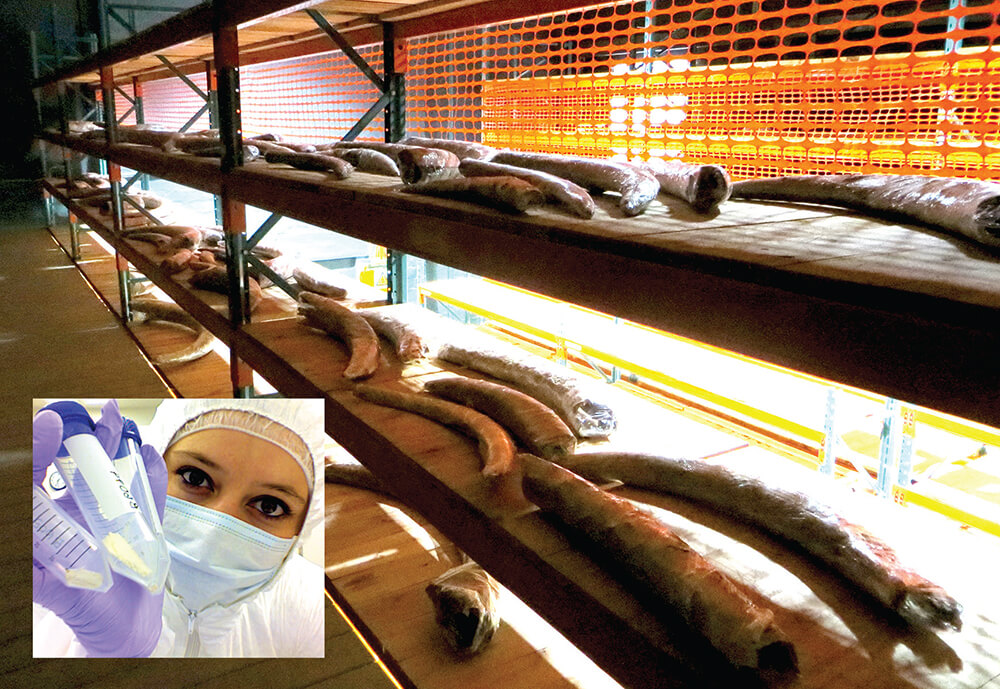
The elephant ivory carried aboard the
Portuguese trader, Bom Jesus, which sank in
1533 en route to India. Inset: Quarter-sized samples are drilled from
the tusks and then pulverized, decalcified, polarized and refined into a few drops of liquid, which Alida de Flamingh analyzes for DNA. (Images courtesy of courtesy of Alida de Flamingh and Ashley Coutu)
There’s a stretch of the Atlantic along Africa known as the Skeleton Coast, where thousands of ships have met their fate. The oldest known victim is the Bom Jesus, a Portuguese trader that went down in 1533 en route to India. In 2008, the ocean disgorged the wreck, with an assist from DeBeers miners dredging the sea floor for diamonds.
The ship was a spectacular find, loaded with gold and silver coins, valuable metals and more than 100 elephant tusks. Deterioration had been miraculously deflected by copper and lead ingots stowed above the tusks that pressed them into the sea floor, where a cold current sustained them for half a millennium thereafter.
For Alida de Flamingh, PHD ’20 ACES, the tusks presented a rare and curious opportunity. She arrived on campus from her native South Africa in 2015 to pursue a Ph.D. and study elephant genetics with Al Roca. Meanwhile, researchers from the University of Cape Town had contacted Roca’s colleague Ripan Malhi, who runs a molecular anthropology lab at Illinois. The researchers had access to the Bom Jesus tusks, now safeguarded in a museum in Namibia, and wanted Malhi’s help in determining the ivory’s origin.
De Flamingh went to work analyzing 44 quarter-sized samples that had been drilled from the tusks and sent to Illinois.
There is nothing easy about extracting genetic material from samples that have been underwater for 500 years. But ancient DNA is Malhi’s specialty. He runs his lab like an epidemiological research facility. Contamination by living DNA—which is everywhere, shed by everything that lives—is the enemy. Airflow into the lab is filtered and positively pressured to repel random particles, and researchers wear white head-to-toe outfits known as “bunny suits.”
De Flamingh donned the bunny suit many times. She pulverized, decalcified, polarized and refined each ivory nugget into a few drops of liquid. Around one in four contained DNA, which was analyzed and sequenced. Combined with carbon isotope dating by the team in Cape Town, the project revealed much about the original owners of the tusks.
They were Loxodonta cyclotis, African forest elephants, from 17 different herds. (Only four of those 17 genetic signatures have been found so far in the vanishing modern population.) They lived in savannah and mixed habitats, rather than deep rainforest, and were probably hunted around Elmina, a fortified Portuguese trading port in the coastal area of Dahomey Gap.
De Flamingh was lead author of the study, published in 2021, which she expects to provide a framework for further research. “There are vast quantities of archaeological ivory from shipwrecks and museums,” she says.
Now a postdoctoral researcher at Illinois, de Flamingh continues to build research collaborations in South Africa and is actively working on the role of genetics in elephant conservation—the subject of her Ph.D. dissertation. “It’s been a very steep, but amazing, learning curve to be working with Al,” she says. “I’m hopeful and excited about the impact our research will have.”—MT

